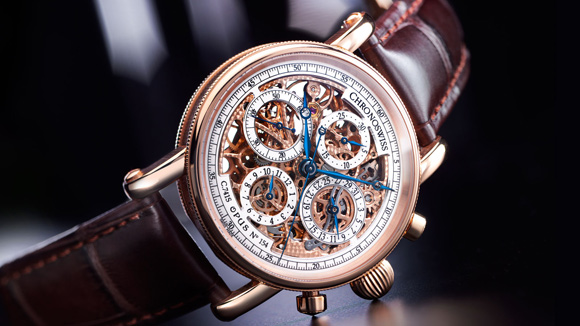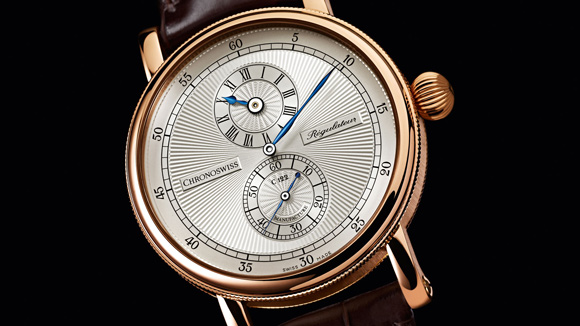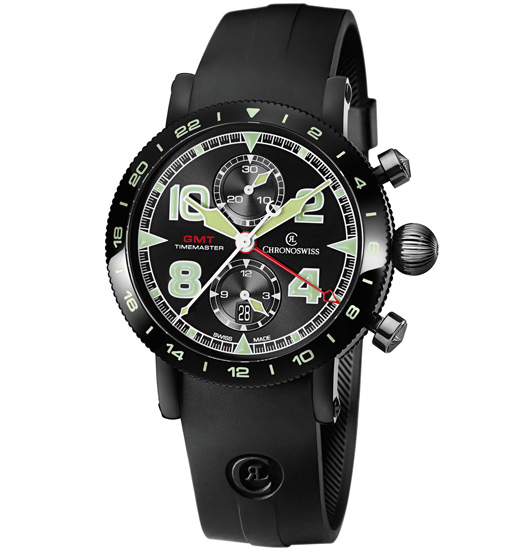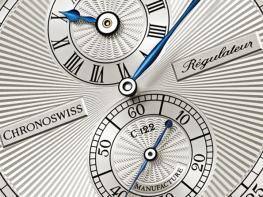What are the distinctive features of a Chronoswiss? Few could answer that, since the brand deliberately cultivates a sense of discretion that tends to make it the exclusive preserve of an informed clientele. Nonetheless, Chronoswiss is firmly devoted to the transparency of its workshops, to the generous sharing of its expertise and to the simplicity of its collections. In a domain where some are constantly striving to offer more models, more complications, etc., the 100% independent firm remains fiercely attached to quality rather than quantity.
So how can you tell a Chronoswiss watch?
In concrete terms, Chronoswiss could be summed up in the numbers two and three. Two, like its collections, which are invariably composed of Sirius and Timemaster models. The former is more classic, and the latter distinctly sporty. A structure that is simple, effective and equally understandable to learned collectors as to first-time buyers.
Three, like the brand’s main identity codes. The most obvious is the onion-shaped crown found on almost all models by the brand. The second typical distinctive feature is its half-fluted case. Both this and the onion-shaped crown are historical reminders of 19th century watchmaking, and particularly pocket watches as far as the crown is concerned. The brand’s third aesthetic signature is located between its lugs, where the strap lugs are secured by screws. While this process does not enable a curved interhorn space that would hug the contours of the case, it nonetheless enables smooth rotation of the strap.
At ease in the world of complications
Within this well-defined yet perpetually evolving framework, Chronoswiss revels in combining various horological complications and subtle display options. Almost 25 years ago, the Delphis was the first wristwatch to combine analogue, digital and retrograde displays. And while a mechanical moonphase chronograph with an exhibition caseback has now become increasingly commonplace, Chronoswiss introduced this type of model back in 1982 – another world first appearing right in the midst of the quartz crisis!

Basically, within the limits that Chronoswiss has set for itself, the company has nothing left to prove. It continues to honour the grand watchmaking tradition with flinqué dials on which a fine guilloché motif appears beneath a layer of colourful enamel. It also honours the memory of its founder, Gerd-R. Lang, who became involved in the field of sports timing right from the early 1960s. He even played a role in the film Le Mans starring Steve McQueen. This heritage has led to the registration of numerous patents in the field of timekeeping.
Strangely enough, the brand has never certified its models to confirm the quality of their isochronism. It nonetheless remains particularly innovative in a domain much favoured by collectors: that of regulators, a sophisticated type of model sadly neglected by the industry as a whole.

A deliberately atypical approach
Chronoswiss clearly enjoys its outsider status. The brand remains 100% independent and private, having been bought up in 2012 by family investors. It has since then crossed the German border to establish itself in Switzerland, where it is distributed exclusively in its own Luzern-based workshop!
Very much in the same spirit, Chronoswiss has also opted to tread an atypical aesthetic path cleverly alternating between openworking and skeleton-working – an option that enables it to maintain certain solid components on which it can express its guilloché-work abilities.
Can we expect to see Chronoswiss venturing into the field of technical materials or more atypical case shapes? This seems fairly unlikely. Meanwhile, the models in the brand’s Timemaster sports collection remain fairly restrained, apart from a distinctive aesthetic signature in the shape of hour-markers interspersed with “2– 4 – 8 – 10” numerals (rather than the conventional 3 – 6 – 9 – 12 configuration), such as one finds at Porsche Design and MAT Watches. Some have expressed hopes of seeing a combination of the brand’s two ranges in the form of regulator chronographs (from the Sirius collection applied to the modern Timemaster models, and duly chronometer-certified by the COSC. Perhaps Baselworld has a few surprises in store…

, ed






